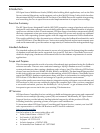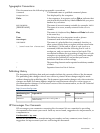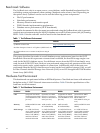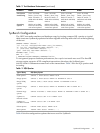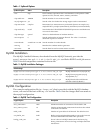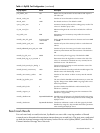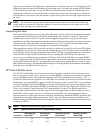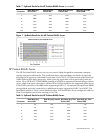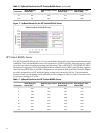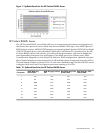
Depending on whether the application requires many read/write queries, it may help to set the
database connection pool to the number of processing cores. For read-only testing, all HP Proliant
c-Class Blade Servers in the test can still handle almost the same number of transactions even
though the number of concurrent threads is double the number of processing cores. Therefore,
more database connections than the number of processing cores for read-only applications can
be used.
NOTE: For read/write testing, the maximum performance (shown in bold in the following
result tables) was achieved when the number of concurrent threads was the same as the total
number of processing cores in the system.
Interpreting the Data
The results of the testing are presented in the following sections and show the maximum number
of tps that each of the systems can handle, depending on the number of threads. The precise
database query load and mix of queries that an application generates vary greatly between
applications. Another important consideration in the benchmark testing was how many concurrent
connections the application had with the database server. The results in the data tables show
that having more connections can negatively impact the throughput.
If an application requires 1200 read/write tps from 16 database connections, all of the HP Proliant
c-Class Blade Servers used in these tests are suitable because all of the test servers can handle at
least 1245 tps. For read-only applications that require 2000 tps using eight database connections,
both the HP ProLiant BL465c and BL685c servers, configured with 2 Dual-Core Opteron
processors, are suitable having a capacity of 2500 tps. The ProLiant BL460c server and BL480c
server, configured with 2 Quad-Core Xeon processors, can handle a maximum of 4500 read-only
tps and 3000 read/write tps. For an application that requires more than 4500 read-only or more
than 3000 read/write tps, consideration should be given to using MySQL Replication and spreading
the load across multiple ProLiant servers.
HP Proliant BL460c Server
The HP ProLiant BL460c server has features that are equal to standard 1U rack-mount servers.
The two-processor, dual-core or quad-core ProLiant BL460c combines power-efficient compute
power, and high density with expanded memory and I/O for maximum performance. The
ProLiant c7000 enclosure supports up to 16 BL460c server blades, two more servers than the IBM
BladeCenter, and each BL460c supports double the memory capacity of the HS21 server without
an expansion blade. The Proliant BL460c now comes with dual-core and quad-core Intel® Xeon®
processors, DDR2 fully buffered DIMMs, Serial Attached SCSI (SAS) or Serial ATA (SATA), hard
drives, and support of multi-function NICs and multiple I/O cards. The BL460c provides a
performance system ideal for the full range of scale-out applications. In this small form factor,
the BL460c includes more features to enable high-availability, such as hot plug hard drives,
mirrored memory, online spare memory, memory interleaving, embedded RAID capability, and
enhanced remote Lights-Out management. Table 7 provides the benchmark results that were
obtained using a ProLiant BL460c server configured with two Quad-Core Intel® Xeon® processors
running at 3.0GHz.
NOTE: Maximum performance appears in bold.
Table 7 SysBench Results for the HP ProLiant BL460c Server
Read Only (tps) Fibre
Channel SAN
Read/Write (tps) Fibre
Channel SAN
Read Only (tps)
Internal SAS
Read/Write (tps)
Internal SASConnections
8096107946241
13301029145410572
16






